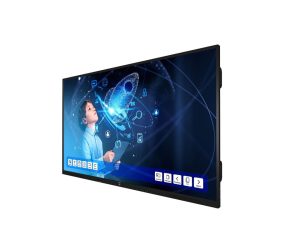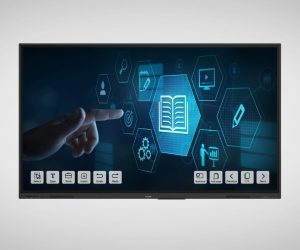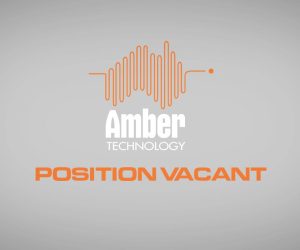
Writing on the Wall
Are the days of the Interactive Whiteboard numbered?
Text & Images:/ Richard Caladine
In the beginning, the writing was on the walls of caves. Then it was on chalkboards. Then came whiteboards. After that came electronic whiteboards. Then came recording devices on whiteboards like eBeam and Mimio. And today we have Interactive Whiteboards. Interactive whiteboards (IWB) can be thought of as large, wall-mounted graphics tablets onto which a computer’s desktop is projected. Users control the computer by touching the board with a stylus or their finger rather than with a mouse.
All of these technologies have problems. Writing on cave walls had its unique difficulties. Chalkboards were messy and the things written on them were ephemeral. Whiteboards solved the problem of the chalky mess but unless a photograph was taken, the writing on the board was equally ephemeral. Electronic whiteboards made it possible to print what was written on the board but the hard copy was not high quality as a whole board of writing was compressed onto an A4 sheet. The recording devices (eBeam, Mimio) produced usable results but the technology was clunky, as there were problems with the enclosures for markers that communicated with receivers that clipped onto whiteboards.
Interactive Whiteboards still have many problems. Even with short throw projectors users have to work in their own shadow, and while projection technology has come a long way, images on IWBs are still quite susceptible to dilution from ambient light. As the projector is physically separate from the IWB, calibration is an ongoing issue, especially with mobile units. Most projectors still require relatively short-lived and expensive replacement lamps. In addition, if someone writes on an early, resistive technology IWB with a whiteboard marker, erasing is difficult and often messy.
As with any technology that has problems, good managers look to the next generation to see if the problems have been addressed.
Most of us who manage audiovisual equipment receive unsolicited promotional material, sometimes on a daily basis. Today was no different. The headline on the glossy brochure was ‘LCD Touchscreens 55-inch – 65-inch’. The company was A Brighter Image P/L (www.abimage.com.au), I enquired about the price and was pleasantly surprised. The recommended retail price was approximately $10,000 and as any good AV manager knows, actual prices are usually lower. Perhaps LCD touchscreens are the answer to the problems with IWBs.
RESISTANCE IS NOT FUTILE
I work at a medium-sized Australian university and have been under a great deal of pressure to install Interactive Whiteboards in teaching rooms on all our campuses. I have been resisting the pressure and so far have installed them in less than 10% of rooms. There are several reasons for my resistance. Some of the reasons are the technological ones mentioned earlier and some of them are about usage.
There is no doubt in my mind that IWBs have a lot to offer primary and secondary education, as they allow students, as well as teachers, to manipulate content. However, I believe the jury is still out on the benefits they bring to higher education. As a manger of AV I have to address the question: If they were installed in all teaching spaces at my university would some or most of them end up being very expensive screens?
So far at my university I have found only two defensible uses of IWBs, and together they make up a very small minority of users. The first group is the people that train future teachers. Their students will be expected to use the IWBs that have been installed in schools, and it makes sense to teach them with the same technology. The second group is those that teach via videoconference to multiple campuses, as networked IWBs provide a way for students at all locations to work on the same virtual board and thus promote cohesion in distributed classes. However, if other users could be encouraged to incorporate interactivity into their presentations, and if the price was right, the technology would enhance the learning experience. Perhaps part of the management of this technology is the training of users. Simply showing them how to use an IWB or touchscreen to annotate their presentations, and how to record the annotations would be a positive first step.



A TOUCHING SOLUTION?
One way to reduce or remove some of the technological problems with IWBs is to use LCD touchscreens. As smartphones and tablets become increasingly popular, it’s reasonable to expect that large and affordable touchscreens are not far away. Cost is the only reason I have approved the installation of IWBs over LCD touchscreens into the 10% of my university’s teaching rooms. To date, touchscreens have been much more expensive, though for the past few years I have been watching the prices of LCD touchscreens and noting the downwards trajectory. For example, the 65-inch Samsung 650TS (that’s TS for touch screen) with an RRP of $14,950 and the 65-inch, $10,000 touchscreen in the ABI brochure are both challengers to IWBs. They are somewhat smaller than the early 77-inch IWBs (which have a 4:3 aspect ratio) and significantly smaller than the latest 87-inch IWBs (which have a 16:10 aspect ratio). I rang the supplier and asked about larger LCD touchscreens but from their responses its clear that production quantities are keeping 75-inch and 80-inch prices very high.
The question is then: how far away are reasonably priced LCD (or LED or OLED) touchscreens that are about the same size as IWBs? Only time and some educated guesswork will tell, but I am one AV manager who is not rushing into the widespread installation of IWBs.
While touchscreen technology has been here for some time in PDAs and tablet computers, it has recently become popular with the success of smartphones and tablets like the iPad. Early touchscreens were single touch compared to the multi-touch screens on current devices that allow complex interactions like rotate, pinch and squeeze that make the interaction experience so much richer.
TECHNOLOGY: TAKING A POSITION
There are several touchscreen technologies and they can be categorised as Resistive, Capacitive, Surface Acoustic Wave, Infrared, Optical Imaging, Dispersive Signal and Acoustic Pulse Recognition. Infrared and Optical Imaging are often referred to as Bezel technologies as they rely on light (usually infra-red or ultra-violet) being transmitted and received in the bezel. The light is transmitted across the screen and shadows of fingers or styluses detected. Simple triangulation then allows the device to ascertain the position of the finger or stylus.
Early interactive whiteboards generally used resistive technology which was single touch. When the surface of a resistive screen is touched the surface deforms sufficiently to allow contact between two resistive sheets underneath. Typically one sheet’s resistance would be measured at 90° to the other. The contact between them changes the resistance of each sheet and hence allows the touch position to be calculated. The deformable surface was generally sheet plastic which was very easy to write on with whiteboard markers but very difficult to erase.
Later interactive whiteboards use a bezel technology that uses multiple cameras to locate the touch position. With camera technology the surface of the IWB can be rigid and some manufacturers are now providing IWBs with hard-coated steel surfaces that are suitable for both projection and dry-erase markers thus removing the problems with erasing. Also the multi-camera technology facilitates multi-touch.
Other recently available optical imaging technologies include cameras and sensor arrays directly behind an LCD screen that ‘look through’ the LCD panel in the infrared spectrum to detect multiple fingers, pointers and even objects on the other side.
Capacitive touchscreen technology, as featured in many smartphones and tablets such as the iPads and iPhones, is multi-touch and is now found in an increasing number of devices. These touchscreens use two layers of glass (or plastic) that are coated with a conductor. The coating may be uniform, a grid pattern or parallel stripes. The stripes on the top sheet can be at right angles to those on the bottom sheet and where the stripes cross, a small capacitor is formed (as a capacitor can be simply two conductors separated by an insulator). As the capacitor is small, the presence of a human finger is sufficient to change the charge and hence reveal the touch position.
SCRATCHING THE SURFACE
No discussion of touchscreens would be complete without a mention of the Microsoft Surface. First conceptualised 10 years ago and unveiled in 2007, the technology is now a real product with the release of the Samsung SU40 earlier this year. Unlike the expensive and unwieldy camera-based system in the original Surface, Microsoft Surface 2.0 uses yet another touchscreen technology from Samsung called PixelSense, in which every pixel is also a low-resolution infra-red camera. This allows detection of multiple points at the same time and the ability to recognise things other than fingers. A different approach has been taken by Dell with its S500wi ultra short throw, interactive projector. This projector employs TI’s DLP Interactive technology which uses the DLP mirror array to overlay an invisible grid on the screen. This is then picked up by a camera in the pen/pointer device to give an exact screen location for interaction; without touching the board. In fact, the Dell blurb says the projector is interactive up to nine metres away.
The touchscreen technology landscape is not a simple one and clearly touchscreens the same size as interactive whiteboards are not affordable just yet. However, in the not too distant future, whether it’s an interactive whiteboard or a touchscreen, the writing will still be on the wall.















RESPONSES